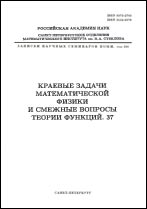|
|
Zapiski Nauchnykh Seminarov POMI, 2004, Volume 312, Pages 86–93
(Mi znsl774)
|
 |
|
 |
This article is cited in 3 scientific papers (total in 3 papers)
Discrete convexity
V. I. Danilov, G. A. Koshevoy
Central Economics and Mathematics Institute, RAS
Abstract:
In the paper we explain what sets and functions on the lattice $\mathbb Z^n$ could be called convex. The basis of our theory is the following three main postulates of the classic convex analysis: concave functions are stable under summation, they are also stable under convolution, and the superdifferential of a concave function is nonempty at each point of the domain. Interesting classes of discrete concave functions (and even dual) arise if we require either the existence of superdifferentials and stability under convolution or the existence of superdifferentials and stability under summation. The corresponding classes of convex sets are obtained as the affinity domains of such discretely concave functions. The first type classes are stable under summation and the second type classes are stable under intersection. In both type classes the separation theorem holds true. Unimodular sets play an important role in the classification of such classes. The so-called polymatroidal discretely concave functions, the most widespread among applications, are related to the unimodular system $\mathbb
A_n:=\{\pm e_i,e_i-e_j\}$. Such functions naturally appear in mathematical economics, play an important role for solution the Horn problem, for describing submodule invariants over rings with discrete valuation, in Gelfand–Tzetlin patterns and so on.
Received: 21.04.2004
Citation:
V. I. Danilov, G. A. Koshevoy, “Discrete convexity”, Representation theory, dynamical systems. Part XI, Special issue, Zap. Nauchn. Sem. POMI, 312, POMI, St. Petersburg, 2004, 86–93; J. Math. Sci. (N. Y.), 133:4 (2006), 1418–1421
Linking options:
https://www.mathnet.ru/eng/znsl774 https://www.mathnet.ru/eng/znsl/v312/p86
|

| Statistics & downloads: |
| Abstract page: | 383 | | Full-text PDF : | 149 | | References: | 51 |
|




 Contact us:
Contact us: Terms of Use
Terms of Use
 Registration to the website
Registration to the website Logotypes
Logotypes








 Citation in format
Citation in format 
